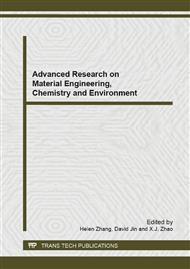p.298
p.302
p.307
p.311
p.315
p.321
p.325
p.329
p.334
Analysis of the Bacterial Community by 454 Pyrosequencing in Two Freshwater Lakes: Yangcheng Lake and Taihu Lake in China
Abstract:
Have a good understanding of the bacterial community structure, especially the cyanobacteria composition, works for clarifying the overall process of harmful algae bloom in freshwater lakes. In this study, the 454 pyrosequencing method was used to investigate the bacterial community in two typical freshwater lakes of China: Yangcheng Lake and Taihu Lake. A total of 30,663 16S rRNA reads were generated from 9 samples and assigned to 3,547 operational taxonomic units (OTUs) which represented 18 recognized phyla. For Yangcheng Lake, the dominant species in both July and early September were Proteobacteria, Actinobacteria, Bacteroidetes and Cyanobacteria. Taihu Lake had the same top three dominant phyla, but with smaller proportion of cyanobacteria. With regard to genus level of cyanobacteria, there were 5 genera which contained toxin-producing ones were identified in Yangcheng Lake, which manifested higher risk for long-term harmful algae injury. The constant level of cyanobacteria proportion from pre-bloom period to forthcoming period indicated that the proliferation of cyanobacteria quantity is more a sudden process not a gradual growth pattern. Only 3 genera were found in Taihu Lake and higher background amount of Microcystis in May of Taihu Lake made it more liable to suffer harmful algae bloom.
Info:
Periodical:
Pages:
315-320
Citation:
Online since:
September 2013
Authors:
Price:
Сopyright:
© 2013 Trans Tech Publications Ltd. All Rights Reserved
Share:
Citation:


